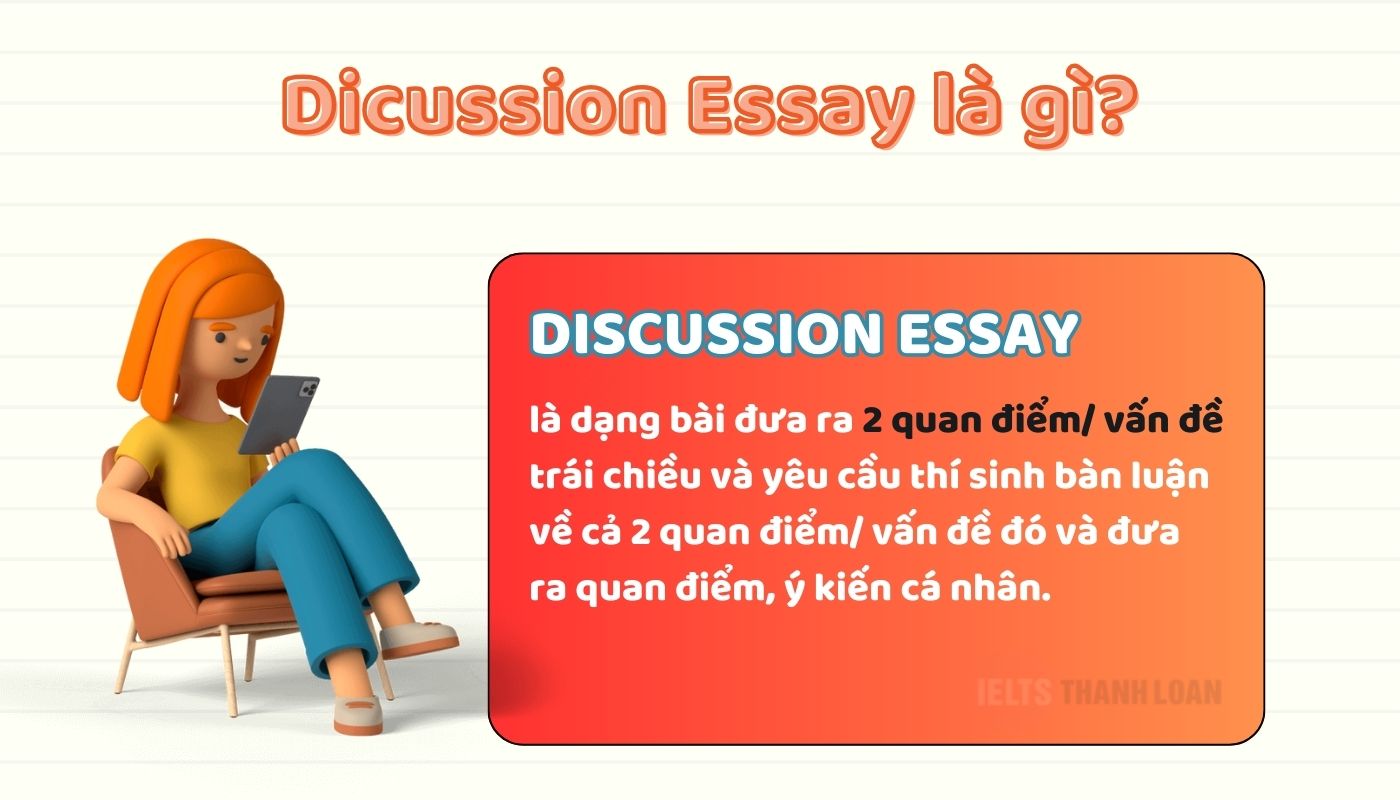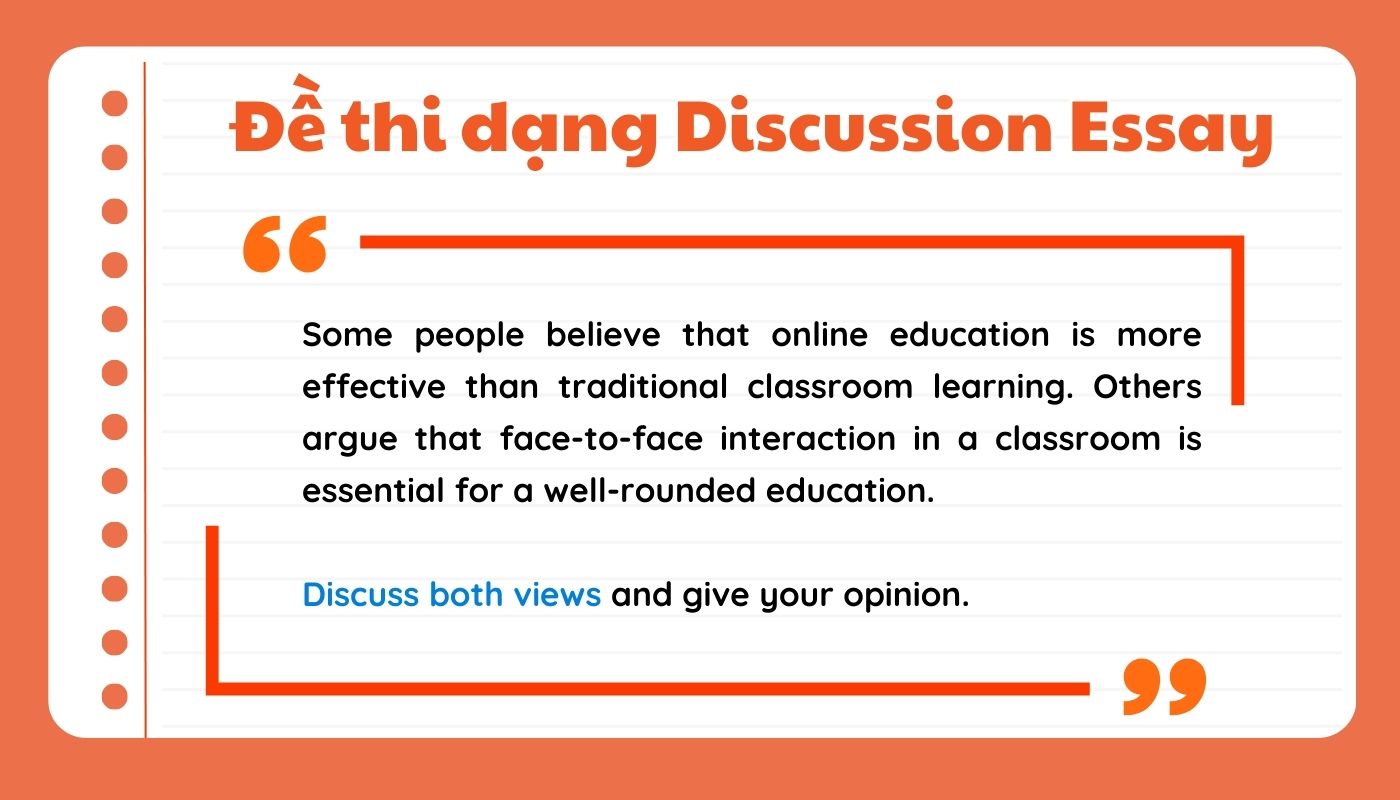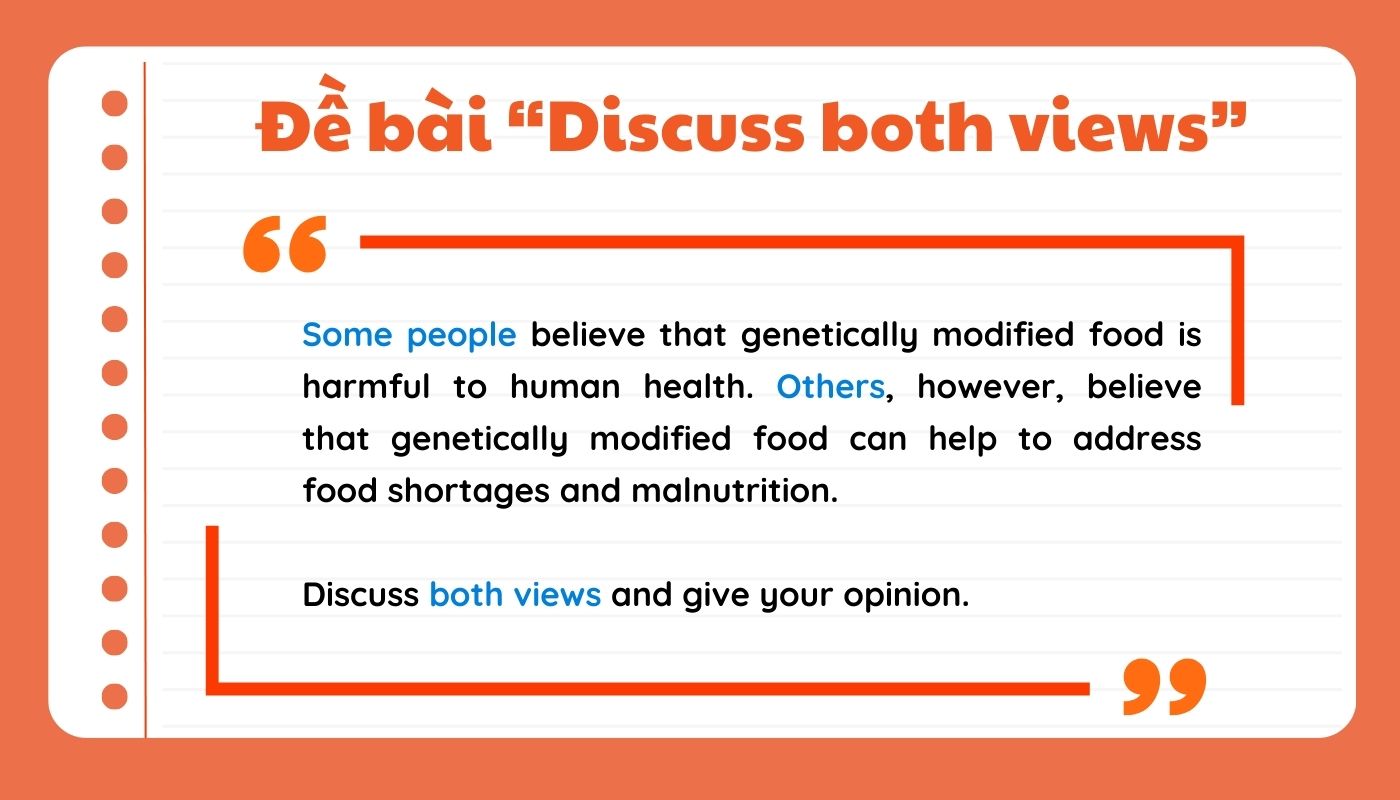Bên cạnh Opinion Essay, Discussion Essay cũng là dạng đề thường gặp trong phần thi IELTS Writing Task 2. Để đạt điểm số cao ở dạng bài này, thí sinh cần hiểu rõ cấu trúc bài viết, cách sắp xếp luận điểm hợp lý và đưa ra các dẫn chứng phù hợp. Trong bài viết này, Trung tâm IELTS Online Thanh Loan sẽ chia sẻ tổng quan cách viết Discussion Essay kèm ví dụ minh hoạ và bài mẫu chi tiết, giúp bạn củng cố kiến thức và hoàn thành tốt bài thi này.
Trước khi tìm hiểu cách viết bài Discussion Essay, hãy cùng IELTS Thanh Loan điểm qua về khái niệm, cấu trúc nội dung và cách nhận biết dạng bài Discussion Essay nhé!
Discussion Essay là gì?
Trong IELTS Writing Task 2, Discussion Essay là một dạng bài thường xuyên xuất hiện, yêu cầu người viết thảo luận về một vấn đề cụ thể dưới góc độ của 02 quan điểm trái ngược nhau. Các vấn đề này có thể là quan điểm xã hội, lý thuyết khoa học, hoặc phương pháp tiếp cận một vấn đề. Với cách viết dạng Discussion Essay, thí sinh cần phân tích bao quát cả hai mặt của vấn đề trước khi đưa ra quan điểm cá nhân.

Dạng bài Discussion Essay trong IELTS Writing Task 2
Tìm hiểu thêm: Cách viết dạng Opinion Essay trong IELTS Writing Task 2
Cách nhận biết dạng Discussion Essay trong Writing Task 2
Đối với dạng bài Discussion Essay, cách nhận biết đơn giản nhất chính là thông qua nội dung của đề bài. Phần đề bài thường yêu cầu thí sinh thảo luận về 02 quan điểm hoặc 02 mặt của một vấn đề, sau đó đưa ra quan điểm cá nhân với những cụm từ như:
- Discuss both views and give your opinion.
- Discuss both these views and then give your own opinion.
- Discuss both sides of this argument and give your own opinion.
Bên cạnh đó, phần nội dung của đề bài sẽ đưa ra 02 lập trường trái ngược nhau, đây cũng chính là 2 khía cạnh mà người viết cần phân tích và thảo luận chi tiết.

Cách nhận biết đề thi dạng Discussion Essay trong Writing Task 2
Cấu trúc và cách viết Discussion Essay chi tiết
Tương tự như các dạng bài Essay khác trong IELTS Writing Task 2, cấu trúc chung của một bài Discussion Essay hoàn chỉnh sẽ bao gồm 3 phần nội dung và 4 đoạn văn chính:
- Phần 1: Introduction (Giới thiệu).
- Phần 2: Body Paragraph (Thân bài)
- Body 1 (Quan điểm mà bạn không đồng tình)
- Body 2 (Quan điểm mà bạn đồng tình)
- Phần 3: Conclusion (Kết luận).
Sau đây là hướng dẫn cách viết Discussion Essay trong Writing Task 2 theo từng dạng bài mà bạn có thể tham khảo!
Cách viết dạng bài Discuss both views and give your opinion
Ở dạng bài này, đề bài sẽ đưa ra 02 luồng quan điểm hoặc ý kiến đối lập nhau về một vấn đề cụ thể. Nhiệm vụ của người viết là phân tích một cách khách quan và công bằng cả hai quan điểm, sau đó trình bày ý kiến cá nhân về việc ủng hộ quan điểm nào. Cách nhận biết dạng bài “Discuss both views” có thể dựa vào các từ khóa như:
- Some people … However, others …
- Discuss both views and give your opinion

Ví dụ đề bài “Discuss both views and give your opinion”
*Hướng dẫn cách viết Discussion Essay dạng “discuss both views”:
Phần 1: Introduction (Giới thiệu chủ đề ngắn gọn trong 2 – 3 câu)
Mở bài Writing Task 2 bằng cách giới thiệu tổng quan về chủ đề được đưa ra trong đề bài. Bạn có thể diễn đạt lại vấn đề bằng cách paraphrase câu hỏi, sau đó nêu rõ quan điểm cá nhân về việc sẽ ủng hộ quan điểm nào.
Phần 2: Body 1 & Body 2 (02 đoạn thân bài)
- Body 1:
- Câu chủ đề: Nhắc lại quan điểm 1 (quan điểm bạn không đồng tình).
- Đưa ra ít nhất 02 lý do giải thích tại sao quan điểm này không được ủng hộ, kèm theo các dẫn chứng, ví dụ cụ thể để chứng minh.
- Body 2:
- Câu chủ đề: Nhắc lại quan điểm 2 (quan điểm bạn đồng tình), đồng thời đưa ra quan điểm cá nhân.
- Trình bày 02 luận điểm giải thích vì sao bạn đồng tình với quan điểm 2, trong đó cung cấp thêm dẫn chứng, ví dụ cụ thể để củng cố lập luận.
*Lưu ý: Đoạn Body 1 là phần thí sinh sẽ phân tích khách quan quan điểm của người khác. Do đó, bạn không được sử dụng đại từ nhân xưng theo ngôi thứ nhất là “I”.
Phần 3: Conclusion (Kết luận)
Trong Conclusion, bạn cần tóm tắt lại các ý chính đã thảo luận trong phần thân bài. Sau đó, khẳng định lại quan điểm cá nhân của mình một cách ngắn gọn.
Ví dụ đề bài:
|
“Governments should ban dangerous sports. Others think that people should have freedom to do any sport activity. Discuss both views and give your opinion” |
→ Giả sử bạn đồng tình với quan điểm: “… people should have freedom to do any sport activity.”, như vậy, dàn ý cách viết Discussion Essay sẽ được triển khai như sau:
1. Introduction
- There is an ongoing debate about whether governments should impose a ban on dangerous sports or allow people the freedom to engage in any sport activity they choose. (Giới thiệu chủ đề bằng cách Paraphrase).
- While some advocate for the prohibition of perilous sports, I believe that individuals should have the freedom to participate in sports of their choice. (Đưa ra quan điểm cá nhân)
2. Body Paragraph
- Body 1: Thảo luận về quan điểm đầu tiên trong đề bài: “Governments should ban dangerous sports”.
- Supporters of banning dangerous sports have some reasons for their position. (Câu chủ đề)
- First, they argue that certain activities pose grave risks, leading to severe injuries or fatalities. Activities such as skydiving, car-racing, mountain climbing, or paragliding involve a high probability of accidents that can strain healthcare systems and families emotionally and financially. (Luận điểm 1)
- Second, there is a valid concern that passionate fans might mimic these sports without proper safety measures, risking their lives and potentially causing accidents. For instance, individuals fascinated by car-racing might replicate risky behaviors on roads, surpassing speed limits, and causing accidents, putting themselves and others at risk. (Luận điểm 2)
- Body 2: Trình bày quan điểm cá nhân về ý kiến còn lại: “Others think that people should have freedom to do any sport activity”, sau đó giải thích vì sao bạn đồng tình với ý kiến này.
- However, I contend that people should have the liberty to engage in sports activities, provided they do not directly harm others. (Câu chủ đề & Quan điểm cá nhân)
- Initially, it is their personal autonomy to choose which sports to partake in. Hence, prohibiting someone from pursuing their passion seems unjustifiable, especially if they are fully aware of the associated risks. (Luận điểm 1)
- Moreover, defining what constitutes a “dangerous sport” is not always clear. Every sport inherently involves some level of risk, including seemingly common sports like football. Imposing an outright ban on specific sports might seem arbitrary and unfair, especially when risks are subjective and can differ among individuals. (Luận điểm 2)
3. Conclusion
- In conclusion,
- While there are valid concerns regarding the dangers associated with certain sports, I believe that individuals should have the autonomy to engage in activities of their preference as long as their actions do not post direct harm to others. (Khẳng định lại quan điểm cá nhân).
→ Bài viết hoàn chỉnh:
“There is an ongoing debate about whether governments should impose a ban on dangerous sports or allow people the freedom to engage in any sport activity they choose. While some advocate for the prohibition of perilous sports, I believe that individuals should have the freedom to participate in sports of their choice.
Supporters of banning dangerous sports have some reasons for their position. First, they argue that certain activities pose grave risks, leading to severe injuries or fatalities. Activities such as skydiving, car-racing, mountain climbing, or paragliding involve a high probability of accidents that can strain healthcare systems and families emotionally and financially. Second, there is a valid concern that passionate fans might mimic these sports without proper safety measures, risking their lives and potentially causing accidents. For instance, individuals fascinated by car-racing might replicate risky behaviors on roads, surpassing speed limits, and causing accidents, putting themselves and others at risk.
However, I contend that people should have the liberty to engage in sports activities, provided they do not directly harm others. Initially, it is their personal autonomy to choose which sports to partake in. Hence, prohibiting someone from pursuing their passion seems unjustifiable, especially if they are fully aware of the associated risks. Moreover, defining what constitutes a “dangerous sport” is not always clear. Every sport inherently involves some level of risk, including seemingly common sports like football. Imposing an outright ban on specific sports might seem arbitrary and unfair, especially when risks are subjective and can differ among individuals.
In conclusion, while there are valid concerns regarding the dangers associated with certain sports, I believe individuals should have the autonomy to engage in activities of their preference as long as their actions do not pose direct harm to others.”
→ Tham khảo chi tiết hơn về cách viết Discussion Essay dạng “Discuss both views” từ IELTS Thanh Loan:
Cách viết essay Discuss both sides and give your opinion
Khác với dạng bài “Discuss both views”, đề bài “Discuss both sides” sẽ yêu cầu thí sinh phân tích một xu hướng hoặc sự phát triển cụ thể trong xã hội. Nhiệm vụ của thí sinh là thảo luận cả 02 mặt: tích cực và tiêu cực của vấn đề, sau đó đưa ra quan điểm cá nhân về việc liệu mặt nào có phần vượt trội hơn. Cách nhận biết dạng bài “Discuss both sides” có thể dựa vào các “dấu hiệu” như:
- Đề bài nêu ra một xu hướng, sự phát triển, hoặc một thực tế hiện tại (Fact/Trend/Development).
- Phần yêu cầu sẽ có các cụm từ như: “Discuss both sides and give your opinion”, hoặc một câu hỏi dạng: “Do you think the advantages outweigh the disadvantages?”.

Ví dụ đề bài “Discuss both sides and give your opinion”
*Hướng dẫn cách làm Discussion Essay dạng “both sides”:
Phần 1: Introduction (Giới thiệu chủ đề ngắn gọn trong 2 – 3 câu)
Ở cách viết mở bài Discussion Essay cho dạng “both sides”, thí sinh có thể giới thiệu chủ đề bằng cách Paraphrase câu văn đầu tiên trong phần câu hỏi. Sau đó đưa ra quan điểm cá nhân về việc liệu mặt tích cực, hay tiêu cực của vấn đề sẽ có ảnh hưởng lớn hơn.
Phần 2: Body 1 & Body 2 (02 đoạn thân bài)
- Body 1:
- Câu chủ đề: Đề cập đến một mặt của vấn đề (khía cạnh mà bạn không đồng tình).
- Đưa ra ít nhất 02 lý do, kèm theo dẫn chứng và ví dụ cụ thể để làm rõ ý.
- Body 2:
- Câu chủ đề: Đề cập đến mặt còn lại của vấn đề (khía cạnh mà bạn đồng tình), đồng thời đưa ra quan điểm cá nhân.
- Trình bày 02 luận điểm để giải thích tại sao khía cạnh này chiếm ưu thế hơn, kèm theo các dẫn chứng và ví dụ minh họa để củng cố lập luận.
Phần 3: Conclusion (Kết luận)
Trong phần Conclusion, thí sinh cần giới thiệu lại chủ đề bằng cách Paraphrase câu văn đầu tiên trong đề bài. Sau đó, khẳng định lại quan điểm cá nhân về việc mặt tích cực, hay tiêu cực của vấn đề sẽ chiếm ưu thế hơn.
Ví dụ đề bài:
|
“Some people think that good health is a basic human need, so medical services should not be run by profit – making companies. Do the advantages of private health care outweigh the disadvantages?” |
→ Giả sử bạn đồng tình với mặt tiêu cực của dịch vụ “Private healthcare” thì dàn ý cách viết Discussion Essay sẽ được triển khai như sau:
1. Introduction
- Good physical well-being is considered a fundamental human necessity, so it is suggested that healthcare services should not be run by non-governmental companies. (Giới thiệu chủ đề bằng cách Paraphrase).
- While there are notable advantages to private healthcare, I contend that the disadvantages seem to outweigh these benefits. (Đưa ra quan điểm cá nhân)
2. Body Paragraph
- Body 1: Thảo luận về mặt tích cực của dịch vụ “Private healthcare”:
- On the one hand, the non-public healthcare system renders several favorable implications. (Câu chủ đề)
- Firstly, private healthcare is often associated with higher levels of innovation and efficiency. The profit-driven nature of these institutions encourages the development of cutting-edge treatments and technologies. (Luận điểm 1)
- Second, private healthcare facilities tend to go the extra mile in terms of patient comfort and experience. This includes amenities like private rooms, personalized care plans, reduced waiting times and complementary therapies. These additional services can significantly enhance the overall patient experience. (Luận điểm 2)
- Body 2: Trình bày quan điểm cá nhân về mặt tiêu cực của dịch vụ “Private healthcare” – khía cạnh mà bạn ủng hộ:
- However, I believe that the downsides of the non-state healthcare system eclipse the above-mentioned benefits. (Câu chủ đề & Quan điểm cá nhân)
- The most prominent drawback of private healthcare is the significant cost associated with it. High premiums, out-of-pocket expenses, and the overall expense of treatments can be prohibitive for a large section of the population. This exacerbates existing healthcare disparities as those with higher incomes receive superior care compared to those with limited resources. (Luận điểm 1)
- Moreover, profit-making companies may sometimes prioritize financial gains over the well-being of patients. This can lead to situations where unnecessary procedures or treatments are recommended, solely for financial gain. This profit-oriented approach can potentially compromise the ethical standards of healthcare. (Luận điểm 2)
3. Conclusion
- In conclusion,
- While private healthcare brings commendable advantages in terms of innovation and additional services, I opine that its drawbacks are substantial. The formidable cost barriers and the potential for profit-driven motives to override patient welfare are significant concerns. (Khẳng định lại quan điểm cá nhân).
→ Bài viết hoàn chỉnh:
“Good physical well-being is considered a fundamental human necessity, so it is suggested that healthcare services should not be run by non-governmental companies. While there are notable advantages to private healthcare, I contend that the disadvantages seem to outweigh these benefits.
On the one hand, the non-public healthcare system renders several favorable implications. Firstly, private healthcare is often associated with higher levels of innovation and efficiency. The profit-driven nature of these institutions encourages the development of cutting-edge treatments and technologies. Secondly, private healthcare facilities tend to go the extra mile in terms of patient comfort and experience. This includes amenities like private rooms, personalized care plans, reduced waiting times and complementary therapies. These additional services can significantly enhance the overall patient experience.
However, I believe that the downsides of the non-state healthcare system eclipse the above-mentioned benefits. The most prominent drawback of private healthcare is the significant cost associated with it. High premiums, out-of-pocket expenses, and the overall expense of treatments can be prohibitive for a large section of the population. This exacerbates existing healthcare disparities as those with higher incomes receive superior care compared to those with limited resources. Moreover, profit-making companies may sometimes prioritize financial gains over the well-being of patients. This can lead to situations where unnecessary procedures or treatments are recommended, solely for financial gain. This profit-oriented approach can potentially compromise the ethical standards of healthcare.
In conclusion, while private healthcare brings commendable advantages in terms of innovation and additional services, I opine that its drawbacks are substantial. The formidable cost barriers and the potential for profit-driven motives to override patient welfare are significant concerns.”
→ Tham khảo chi tiết cách viết Discussion Essay dạng “Discuss both sides” từ IELTS Thanh Loan
Một số từ vựng thường gặp trong Discussion Essay
Để triển khai cách viết bài Discussion Essay trở nên mạch lạc và thuyết phục, việc sử dụng từ vựng chính xác và phong phú là rất quan trọng. Dưới đây là các nhóm từ vựng phổ biến giúp bạn diễn đạt logic hơn khi thảo luận các quan điểm trong dạng bài Discussion Essay.

Nhóm từ vựng thường gặp trong dạng bài Discussion Essay
- Từ vựng thảo luận vấn đề
| Từ vựng | Nghĩa |
| On the one hand… | Một mặt… |
| On the other hand… | Mặt khác… |
| Supporters of this view argue that… | Những người ủng hộ quan điểm này cho rằng |
| Opponents claim that… | Những người phản đối lập luận rằng |
| Advocates believe that… | Những người tán thành cho rằng |
| Critics argue that… | Những người chỉ trích cho rằng |
| Proponents suggest that… | Những người đề xuất cho rằng |
| In contrast… | Ngược lại… |
| However… | Tuy nhiên… |
| Nevertheless… | Dù vậy… |
| On the contrary… | Trái lại… |
- Từ vựng đưa ra ý kiến cá nhân
| Từ vựng | Nghĩa |
| In my opinion… | Theo ý kiến của tôi… |
| I firmly believe that… | Tôi tin chắc rằng… |
| Personally, I think… | Cá nhân tôi nghĩ… |
| From my perspective… | Theo quan điểm của tôi… |
| It seems to me that… | Có vẻ như đối với tôi… |
| I am of the opinion that… | Tôi có quan điểm rằng… |
- Từ vựng chỉ lý do và dẫn chứng
| Từ vựng | Nghĩa |
| This is because… | Điều này là vì… |
| The main reason is… | Lý do chính là… |
| For instance/ For example… | Ví dụ là… |
| Such as… | Chẳng hạn như… |
| According to… | Theo… |
| Including … | Bao gồm … |
| Namely … | Cụ thể là … |
| Proof of this … | Bằng chứng cho điều này |
- Từ vựng kết luận
| Từ vựng | Nghĩa |
| In conclusion… | Kết luận là… |
| To sum up… | Tóm lại… |
| All things considered… | Sau khi cân nhắc tất cả mọi thứ… |
| Taking everything into account… | Xét mọi thứ… |
| In summary… | Tóm lại… |
| Ultimately… | Cuối cùng… |
- Từ nối chỉ kết quả
| Từ vựng | Nghĩa |
| As a result | Kết quả là |
| As a consequence | Hệ quả là |
| Therefore | Vì vậy |
| Thus | Do đó |
| Consequently | Do đó, kết quả là |
| Hence | Do đó |
| For this reason | Vì lý do này |
| Due to | Do, vì |
- Từ nối cung cấp thêm thông tin
| Từ vựng | Nghĩa |
| Additionally | Thêm vào đó |
| Furthermore | Hơn nữa |
| Also | Cũng |
| Too | Cũng |
| As well as that | Cùng với điều đó |
| Along with | Cùng với |
| Besides | Ngoài ra |
| In addition | Ngoài ra |
| Moreover | Hơn nữa |
| In addition to this | Ngoài việc này |
| Apart from this | Ngoài điều này |
Xem thêm: Tổng hợp từ vựng IELTS Writing Task 2 theo chủ đề
Các lỗi thường gặp khi viết Discussion Essay

Một số lỗi thường gặp khi làm dạng bài Discussion Essay
Cách viết Discussion Essay đạt điểm cao là ngoài việc nắm rõ cấu trúc bài viết và các bước triển khai, thí sinh cũng cần lưu ý một số lỗi thường gặp trong cách viết dạng Discussion Essay bao gồm:
- Không đưa ra quan điểm cá nhân: Nếu đề bài yêu cầu “Discuss both views and give your opinion”, tức là sau khi thảo luận về cả 02 quan điểm, người viết cần đưa ra quan điểm cá nhân của mình. Nhiều thí sinh chỉ tập trung phân tích các quan điểm mà quên đưa ra ý kiến của bản thân, dẫn đến mất điểm ở tiêu chí Task Achievement (Đáp ứng yêu cầu đề bài).
- Không cung cấp luận điểm và dẫn chứng hỗ trợ: Khi trình bày quan điểm, bạn cần cung cấp các luận điểm, dẫn chứng cụ thể để làm rõ ý kiến đã đưa ra. Nếu chỉ đơn thuần nêu ý kiến mà không phân tích, hoặc đưa ra các ví dụ minh họa sẽ khiến bài viết trở nên thiếu thuyết phục.
- Phân tích vấn đề không đồng đều: Một lỗi phổ biến khác trong cách viết Discussion Essay là thí sinh không phân tích đồng đều cả 02 mặt của vấn đề. Nếu bạn tập trung quá nhiều cho một quan điểm và không đủ thông tin cho quan điểm còn lại, bài viết sẽ mất đi tính cân bằng về nội dung.
- Thiếu sự đa dạng trong từ vựng: Việc lặp lại từ vựng quá nhiều có thể khiến bài viết trở nên nhàm chán và không đạt yêu cầu về tiêu chí Lexical Resource. Để ăn trọn điểm ở tiêu chí từ vựng, thí sinh nên sử dụng từ đồng nghĩa và đa dạng hóa cách diễn đạt để làm nội dung phong phú hơn.
Bài mẫu dạng Discussion Essay

Tổng hợp bài mẫu dạng Discussion Essay cùng từ vựng hay
Đề bài 1: (Cam 11 Test 4 Writing Task 2)
Discuss both these views and give your own opinion.
- Dạng câu hỏi: Discuss both views (Discussion Essay)
- Bài viết tham khảo:
“People hold different views about which progress is important to a country. Some enunciate the idea that economic growth is the ultimate goal of every government, I agree with the idea that other measures of progress, including happiness and environmental sustainability, are as crucial.
On the one hand, boosting the economy is a vital aim that all countries wish to achieve. Firstly, a healthy economy is a prerequisite for the government to enhance life quality, for they have money to upgrade public facilities and provide better public services. For instance, only when the economy creates enough profit and then contributes to the state budget via tax can the medical service can be provided free of charge to all citizens, thus ensuring better health. Secondly, a strong economy also increases the status of a nation on the global stage. In other words, a prosperous country will have political influences on others, demonstrated by the power of America now.
On the other hand, I would argue that other equally significant factors should be taken into consideration. The first measurement is well-being since richness does not always mean happiness and good health. A telling example is Japan, which is also one of the giants in the global economy, but citizens often face stress because of excessive workload. The second consideration is environmental protection because the growth of the economy normally goes with the booming of manufacturing plants, the natural resources exploitation, and the increasing production of waste. Without environmental conservation, severe contamination is inevitable, leading to health deterioration and other more serious consequences.
In conclusion, economic development is indeed the key marker of a country’s success, but other criteria, which are well-being and environmental protection, are equally vital.”
- Từ vựng hay:
ultimate (adj) /ˈʌl.tɪ.mət/
Vietnamese: tối ưu
English: most extreme; best, worst, greatest, most important, etc.
sustainability (noun) /səˌsteɪ.nəˈbɪl.ɪ.ti/
Vietnamese: sự bền vững
English: the use of natural products and energy in a way that does not harm the environment
prerequisite (noun) /prɪˈrek.wɪ.zɪt/
Vietnamese: điều kiện tiên quyết
English: something that must exist or happen before something else can happen or be done
prosperous (adj) /ˈprɑːs.pər.əs/
Vietnamese: thịnh vượng
English: rich and successful
well-being (noun) /ˌwelˈbiː.ɪŋ/
Vietnamese: sức khỏe và niềm vui
English: general health and happiness
giant (noun) /ˈdʒaɪ.ənt/
Vietnamese: gã khổng lồ
English: a very large and powerful organization
excessive (adj) /ɪkˈses.ɪv/
Vietnamese: quá nhiều, dư thừa
English: greater than what seems reasonable or appropriate
severe (adj) /səˈvɪər/
Vietnamese: cực kì tồi tệ
English: extremely bad or serious
inevitable (adj) /ɪˈnev.ɪ.tə.bl̩/
Vietnamese: không thể tránh khỏi
English: that you cannot avoid or prevent
deterioration (noun) /dɪˌtɪə.ri.əˈreɪ.ʃən/
Vietnamese: sự suy giảm
English: the fact or process of becoming worse
Đề bài 2:
Discuss both views and give your opinion.
- Dạng câu hỏi: Discuss both views (Discussion Essay)
- Bài viết tham khảo:
“International cooperation has become increasingly important in today’s interconnected world. Some argue that the primary advantage of such collaboration lies in protecting the environment, while others believe that the main focus should be on global business. Both perspectives offer valid points, and I think a balanced view is necessary to understand the significance of each.
On the one hand, proponents of environmental protection emphasize the global nature of environmental challenges. Issues like climate change, deforestation, and ocean pollution affect every country and require a collective response. International cooperation allows nations to pool resources, share expertise, and implement global policies that can significantly mitigate environmental damage. For example, the Paris Agreement brought together nearly every country to combat climate change, setting binding targets for reducing carbon emissions. Without such cooperation, individual efforts would likely be insufficient to address these large-scale problems.
On the other hand, advocates for focusing on global business argue that economic cooperation drives innovation, creates jobs, and lifts people out of poverty. International trade agreements, such as the World Trade Organization (WTO), foster economic growth by reducing tariffs and encouraging the free flow of goods and services. This, in turn, can lead to technological advancements that benefit multiple sectors, including the environment. For instance, the rise of renewable energy technologies like wind and solar power has been accelerated by global business partnerships and investment.
In conclusion, I believe that both environmental protection and global business are equally important in international cooperation. In fact, sustainable business practices and environmentally conscious economic policies can ensure that both priorities are met.”
- Từ vựng hay:
global business (n): kinh doanh toàn cầu
Giải thích: business operations that involve or affect companies around the world
Ví dụ: Global business is crucial for companies aiming to expand their markets internationally.
emphasize (v): nhấn mạnh
Giải thích: to give special importance or attention to something
Ví dụ: The teacher emphasized the importance of regular practice.
collective response (n): phản ứng, lời kêu gọi tập thể
Giải thích: a reaction or action taken by a group of people or entities together
Ví dụ: A collective response is needed to tackle the climate crisis effectively.
pool (v): góp chung, kết hợp
Giải thích: to combine resources or efforts for a common purpose
Ví dụ: Several companies pooled their resources to develop new technology.
mitigate environmental damage (v): giảm thiểu thiệt hại môi trường
Giải thích: to reduce the harm or negative effects on the environment
Ví dụ: New regulations aim to mitigate environmental damage caused by industrial waste.
binding targets (n): mục tiêu bắt buộc
Giải thích: goals that are legally required or must be met
Ví dụ: The agreement includes binding targets for reducing carbon emissions.
insufficient (adj): không đủ
Giải thích: not enough or inadequate
Ví dụ: The funds were insufficient to complete the project on time.
economic cooperation (n): hợp tác kinh tế
Giải thích: collaboration between countries or organizations to improve economic conditions
Ví dụ: Economic cooperation between nations can lead to mutual growth and prosperity.
lift out of poverty (v): thoát khỏi nghèo đói
Giải thích: to help people or communities rise above poverty
Ví dụ: Access to education is key to lifting people out of poverty.
international trade agreements (n): hiệp định thương mại quốc tế
Giải thích: formal arrangements between countries to regulate trade across borders
Ví dụ: International trade agreements can reduce tariffs and promote economic growth.
tariffs (n): thuế quan
Giải thích: taxes imposed on imported or exported goods
Ví dụ: The government increased tariffs on foreign goods to protect local industries.
free flow (n): dòng chảy tự do
Giải thích: the unrestricted movement of goods, services, or information
Ví dụ: Free flow of information is essential for a globalized economy.
accelerate (v): tăng tốc, đẩy nhanh
Giải thích: to speed up or cause something to happen faster
Ví dụ: Governments are working to accelerate the development of renewable energy.
global business partnerships (n): quan hệ đối tác kinh doanh toàn cầu
Giải thích: collaborations between companies across different countries to achieve business goals
Ví dụ: Global business partnerships can open up new markets and opportunities.
Đề bài 3:
Discuss both sides and give your opinion.
- Dạng câu hỏi: Discuss both sides (Discussion Essay)
- Bài viết tham khảo:
“The phenomenon of uniformity in shops and products across many countries is a topic of considerable debate. Some view this trend positively while others criticize it. This essay will discuss both perspectives before presenting my own viewpoint.
On the one hand, the standardization of shops and products offers numerous advantages. Primarily, it ensures a consistent shopping experience regardless of location. For example, a customer can expect the same quality and range of products when visiting a well-known retail chain in Tokyo or New York. This predictability can be particularly reassuring for travelers and expatriates, who may prefer familiar brands and services in an unfamiliar environment. Moreover, standardized products often come with economies of scale, which can lead to lower prices for consumers. Large multinational companies can afford to reduce costs through mass production and bulk purchasing, passing on the savings to customers. This is evident in the widespread availability of affordable electronics, clothing, and household items from global brands.
Conversely, I opine that the proliferation of identical shops and products worldwide can have several negative implications. A significant concern is the loss of cultural identity and uniqueness. Local businesses, which often offer unique and culturally significant products, struggle to compete with large multinational corporations. For instance, the global dominance of fast-food chains has overshadowed local eateries in many cities, diminishing the variety of culinary experiences available to residents and visitors alike. Furthermore, the emphasis on uniformity can stifle creativity and innovation. Local entrepreneurs who bring diverse and innovative products to the market may find it difficult to survive against established global brands. This can lead to a reduction in the variety of products available and limit consumers’ choices to a few dominant brands.
In conclusion, from my vantage point, the global uniformity of shops and products has both positive and negative aspects. While it provides consistency and affordability, it also risks undermining local cultures and reducing diversity.”
- Từ vựng hay:
uniformity (n): tính giống nhau, tính đồng dạng
Giải thích: the quality or fact of being the same, or of not changing or being different in any way
Ví dụ: We do not seek to impose total uniformity on every single decision that is made.
shopping experience (n): trải nghiệm mua sắm
Giải thích: the experience of purchasing goods or services from stores or online platforms
Ví dụ: I enjoyed my shopping experience at the mall, browsing through various shops and trying on different clothes.
predictability (n): tính có thể nói trước; tính có thể đoán trước, tính có thể dự đoán
Giải thích: the state of knowing what something is like, when something will happen, etc
Ví dụ: Although her job is boring and monotonous, she likes the sense of predictability and security that it gives her.
expatriate (n): người cách xa quê hương
Giải thích: someone who does not live in their own country
Ví dụ: A large community of expatriates has settled there.
bulk purchasing (n): sự mua hàng số lượng lớn
Giải thích: purchasing goods in large quantities at a discounted rate
Ví dụ: The restaurant owner saved money by bulk purchasing ingredients like rice and vegetables from wholesalers.
proliferation (n): sự phổ biến
Giải thích: the fact of something increasing a lot and suddenly in number or amount
Ví dụ: The past two years have seen the proliferation of TV channels.
cultural identity (n): bản sắc văn hoá
Giải thích: the sense of belonging and identification with a particular cultural group or community
Ví dụ: Growing up in a multicultural neighborhood, Sarah embraced her cultural identity by celebrating both Diwali and Christmas with her friends.
multinational corporation (n): tập đoàn đa quốc gia
Giải thích: large companies that operate in multiple countries, often with headquarters in one country and subsidiaries in others
Ví dụ: Coca-Cola is a prime example of a multinational corporation, with operations and sales in over 200 countries worldwide.
local eatery (n): quán ăn địa phương
Giải thích: small restaurants or food establishments that serve local cuisine, often characterized by their authentic flavors and affordable prices
Ví dụ: In Hanoi, you can find delicious pho and banh mi at local eateries tucked away in narrow alleys.
culinary experience (n): trải nghiệm ẩm thực
Giải thích: the enjoyment and exploration of different cuisines and culinary traditions
Ví dụ: My trip to Italy was a culinary experience, where I indulged in authentic pizza and pasta dishes prepared by skilled chefs.
stifle (v): ngăn chặn, kìm nén
Giải thích: to prevent something from happening, being expressed, or continuing
Ví dụ: I don’t know how I managed to stifle my anger.
Luyện kỹ năng IELTS nhanh chóng cùng IELTS Thanh Loan
Tự hào với 10 năm kinh nghiệm luyện thi cho hàng nghìn học viên trên cả nước, IELTS Thanh Loan là trung tâm dạy IELTS online uy tín chuyên cung cấp các khóa học tiếng Anh IELTS Online chất lượng hàng đầu. Nổi bật với lộ trình học tinh gọn, chú trọng vào thực hành, khóa học IELTS trực tuyến tại IELTS Thanh Loan sẽ giúp học viên nhanh chóng nâng cao toàn diện 4 kỹ năng bởi nhiều ưu điểm như:
- Lộ trình học cá nhân hóa: Các khóa học IELTS Online được thiết kế phù hợp theo trình độ và nhu cầu của người Việt học IELTS. Nhờ vậy, học viên sẽ được tập trung cải thiện điểm yếu, củng cố điểm mạnh cũng như nâng cao từng kỹ năng Nghe – Nói – Đọc – Viết một cách hiệu quả nhất. Không những thế, khi theo học tại trung tâm, học viên sẽ nhận được sự hỗ trợ tận tâm từ cô Thanh Loan – giáo viên giảng dạy IELTS có 10 năm kinh nghiệm cùng chứng chỉ TESOL toàn cầu.
- Nắm vững từ A – Z các chủ điểm ngữ pháp: Khi tham gia khóa học, học viên sẽ được trang bị toàn diện các kiến thức ngữ pháp quan trọng, được giảng dạy theo trình tự từ cơ bản đến nâng cao.
- Chiến lược làm bài hiệu quả cho 4 kỹ năng: Tại IELTS Thanh Loan, học viên không chỉ được trang bị nền tảng ngữ pháp vững chắc mà còn được chia sẻ những chiến lược làm bài IELTS hiệu quả.
- Tài nguyên học tập phong phú: Sau khi đăng ký khóa luyện thi tại trung tâm, học viên sẽ được cấp tài khoản để truy cập vào hệ thống học liệu phong phú với 200+ video bài giảng, bao gồm: tài liệu luyện thi, bài tập thực hành, các bài thi thử IELTS,…
Nhìn chung, với lộ trình luyện thi mang tính cá nhân hoá cao, phù hợp với người Việt học IELTS, các sĩ tử sẽ được cô Thanh Loan tận tâm hướng dẫn ôn tập từng bước, từ việc nắm vững các chủ điểm ngữ pháp, từ vựng cơ bản trong IELTS cho đến nâng cao toàn diện 4 kỹ năng Nghe – Nói – Đọc – Viết. Nếu bạn quan tâm đến khóa học IELTS Online tại IELTS Thanh Loan, hãy liên hệ ngay đến trung tâm để nhận tư vấn chi tiết về học phí và lộ trình luyện thi nhé!
Như vậy, IELTS Thanh Loan đã chia sẻ tổng quan về cách viết Discussion Essay trong IELTS Writing Task 2 với ví dụ chi tiết và bài mẫu minh hoạ cụ thể. Hy vọng với những kiến thức hữu ích này, bạn sẽ biết cách viết bài Discussion Essay và áp dụng hiệu quả vào bài thi IELTS Writing. Nếu có bất kỳ thắc mắc liên quan đến khóa học IELTS, đừng ngần ngại liên hệ ngay đến IELTS Thanh Loan để nhận tư vấn chi tiết nhất.













